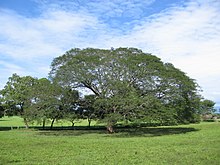Guanacaste
| Guanacaste | |
|---|---|

| |
| Specimen in El Canchol, Guanacaste (Costa Rica) | |
| Scientific classification | |
| Kingdom: | Plantae |
| Clade: | Tracheophytes |
| Clade: | Angiosperms |
| Clade: | Eudicots |
| Clade: | Rosids |
| Order: | Fabales |
| Family: | Fabaceae |
| Subfamily: | Caesalpinioideae |
| Clade: | Mimosoideae |
| Genus: | Enterolobium |
| Species: | E. cyclocarpum
|
| Binomial name | |
| Enterolobium cyclocarpum | |
| Synonyms | |
|
Several, see text | |
Guanacaste (Enterolobium cyclocarpum) also known as elephant-ear tree or devil's ear is a species of flowering tree in the pea family, Fabaceae. It is native to tropical regions of the Americas. It is the national tree of Costa Rica.
Common names in some other languages are:[1]
- Spanish: guanacaste, árbol de las orejas, parota
- French: bois tanniste rouge, oreille d'éléphant
- German: Affenseife
Enterolobium cyclocarpum, the scientific name of the guanacaste tree was given by August Grisebach to this plant in 1864.[2]
Synonyms[change | change source]
- Albizia longipes Britton & Killip
- Enterolobium cyclocarpa (Jacq.) Griseb.
- Feuilleea cyclocarpa (Jacq.) Kuntze
- Inga cyclocarpa' (Jacq.) Willd.
- Mimosa cyclocarpa Jacq.
- Mimosa parota Sesse & Moc.
- Pithecellobium cyclocarpum (Jacq.) Mart.
- Prosopis dubia Kunth
- Prosopis dubia Guill. & Perr.[3]
Description[change | change source]

The guanacaste is a large tree, growing to 20–30 m (66–98 ft) tall, with a trunk up to 3 m (9.8 ft) in diameter. The bark is light gray. The crown (the upper part of tree) is broad and widely spreading. Leaves are 15 to 50 cm (5.9 to 19.7 in) long, alternate and compound.[4]
The guanacaste is evergreen, or briefly deciduous for 1–2 months during the dry season (without rains). Most leaves fall in December, at the start of the dry season. In late February, leaves start to appear and produce a fresh, thick crown by April.
Flowers are hermaphrodite; the pollination is by insects like bees.
The fruit is a legume (also known as a pod) with the shape of a human ear.
Where it grows[change | change source]
The guanacaste tree is native to tropical America. It grows from southern Mexico through Central America to northern South America. It is found also in the West Indies. It has been introduced in other tropical regions.[4]
It grows normally at an elevation from sea level to 500 m (1,600 ft), usually along the coast and rivers.[4]
Uses[change | change source]
The wood is reddish-brown, lightweight and water-resistant; it is used to make objects like doors, windows, furniture, cabinets, and for shipbuilding. It is used also as firewood.
Gallery[change | change source]
-
Branches and foliage of a young Enterolobium cyclocarpum
-
Flowers of guanacaste
-
Fruits of guanacaste
-
Guanacaste tree in Liberia, Costa Rica
References[change | change source]
- ↑ "Taxon: Enterolobium cyclocarpum (Jacq.) Griseb". U.S. National Plant Germplasm System (NPGS/GRIN). Retrieved 12 December 2016.
- ↑ "Flora of the British West Indian islands". Biodiversity Heritage Library (BHL). Retrieved 12 December 2016.
- ↑ "Enterolobium cyclocarpum (Jacq.) Griseb". The Plant List. Retrieved 12 December 2016.[permanent dead link]
- ↑ 4.0 4.1 4.2 "Enterolobium cyclocarpum" (PDF) (in Spanish). México: Comisión Nacional para el Conocimiento y Uso de la Biodiversidad (CONABIO). Retrieved 12 December 2016.





